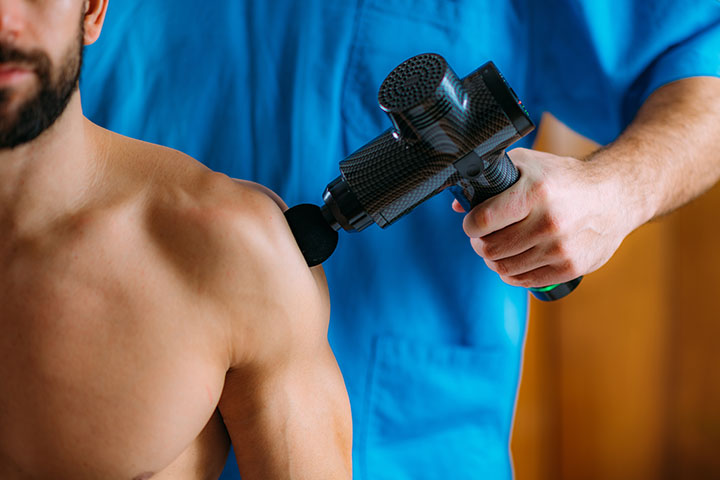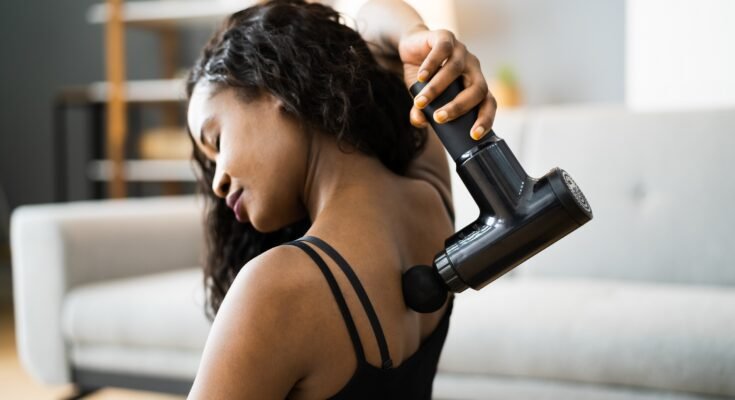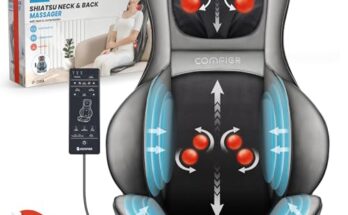Have you ever wondered when it’s time to put down your trusty massage gun? These handy devices have become a go-to tool for easing muscle tension and boosting recovery.
But just like any tool, knowing when to use it—and when to stop—is crucial for getting the best results. You’ll discover the signs that indicate it’s time to take a break from your massage gun. By understanding these signals, you can maximize the benefits and avoid any potential downsides.
So, if you’re eager to ensure you’re using your massage gun effectively and safely, keep reading. Your muscles will thank you!

Signs Of Overuse
Experiencing bruising, increased pain, or numbness may indicate overuse of a massage gun. Discomfort or irritation in targeted muscles suggests it’s time to pause. Always pay attention to your body’s signals to prevent harm.
Knowing when to stop using a massage gun is crucial to prevent potential harm to your body. Overusing this handy device can lead to several uncomfortable signs, indicating it’s time to take a break. Recognizing these signs can help ensure that your massage gun use remains beneficial rather than detrimental.Persistent Soreness
Feeling sore for a day after using a massage gun is normal. However, if your muscles remain sore for several days, it could be a red flag. Your body might be telling you that it’s had enough. Consider the last time you pushed through a workout despite your muscles pleading for rest. Did the soreness linger longer than expected? This is similar. Your muscles need time to recover, and overuse can hinder this process.Increased Pain Levels
A massage gun should alleviate pain, not increase it. If you notice that your discomfort worsens after a session, it’s a clear indication to stop. Have you ever noticed how pushing through pain during a workout often leads to injury? The same principle applies here. Listening to your body’s pain signals is crucial.Fatigue After Use
Using a massage gun should leave you feeling refreshed, not drained. If you experience fatigue or exhaustion following its use, it’s time to reconsider your approach. Think back to a time when you overdid a workout or physical activity and felt wiped out afterward. This fatigue might be your body’s plea for a gentler touch. Have you ever questioned whether more is always better? When it comes to using a massage gun, less can indeed be more. Recognizing these signs of overuse can help you maintain a balanced and beneficial routine.
Potential Risks
Massage guns offer great muscle relief. Yet, they pose certain risks. Understanding these risks helps prevent injury and discomfort. It’s important to know when to pause or stop using a massage gun. This ensures you enjoy its benefits without harm. Let’s explore the potential risks.
Muscle Damage
Using a massage gun too long can harm muscles. Overuse stresses muscle fibers. It can lead to small tears. These tears cause pain and slow recovery. Listen to your body. Stop if you feel unusual pain.
Nerve Compression
Nerves can get compressed by deep pressure. This causes tingling or numbness. Long sessions increase this risk. Avoid using the gun on the same area for extended periods. If you feel numbness, take a break.
Bruising And Skin Irritation
Massage guns can bruise skin. This happens with high intensity or sensitive skin. Redness and irritation are signs to watch. Use lower settings if bruising occurs. It’s best to stop until skin heals.
Health Conditions To Consider
Using a massage gun can be a fantastic way to relieve muscle tension and boost recovery. However, it’s crucial to recognize when it might not be the right tool for you. Before using a massage gun, consider your health conditions and seek advice if needed. Understanding these can prevent further injuries and ensure safe usage.
Existing Injuries
If you have any existing injuries, think twice before using a massage gun. Suppose you have a sprained ankle or a pulled muscle. Applying pressure with a massage gun might worsen the injury. Always consult with a healthcare professional to determine if massage therapy is suitable for your specific injury.
Chronic Pain Disorders
Individuals with chronic pain disorders, like fibromyalgia, need to be cautious. Massage guns can sometimes be too intense and exacerbate pain rather than alleviate it. Consider softer alternatives, like gentle stretching or a warm bath, which might be more beneficial for managing chronic pain.
Circulatory Issues
People with circulatory issues, such as varicose veins or blood clots, should avoid massage guns. The intense vibrations might disrupt blood flow and cause complications. If you have a circulatory condition, consult with your doctor before considering any form of massage therapy.
Have you ever found yourself using a massage gun without considering your health conditions? It’s easy to overlook, especially when you’re eager to relieve tension. But your body deserves careful attention and care. Always prioritize safety over quick relief.

Recommended Usage Frequency
Using a massage gun can be a game-changer for muscle recovery and stress relief. However, understanding the recommended usage frequency is key to maximizing benefits without risking injury. Whether you’re an athlete pushing your limits or someone seeking relaxation after a long day, knowing when and how often to use your massage gun can make all the difference. Let’s dive into the details.
Daily Limits
It’s tempting to use a massage gun daily, especially if you feel sore or tense. But moderation is crucial. Overusing it can lead to bruising or muscle damage. It’s generally recommended to limit usage to once a day. Have you ever noticed that overdoing a good thing can sometimes backfire? The same principle applies here.
Duration Of Sessions
While a quick session might seem harmless, extended use can cause more harm than good. Aim for 1-2 minutes per muscle group. This ensures adequate relief without overworking the area. If you’ve ever used a massage gun for longer, you might have felt more soreness than before. Keep sessions short to stay on the safe side.
Body Part Considerations
Not all body parts are created equal when it comes to massage gun usage. Some areas, like the neck or joints, are more sensitive. Stick to larger muscle groups like the thighs or back for the best results. Ever tried using a massage gun on your shin? It’s not a pleasant experience. Focus on areas that can handle the pressure.
By understanding these guidelines, you can use a massage gun effectively and safely. Remember, it’s not just about frequency but also about being mindful of your body’s signals. Are you listening to what your muscles are telling you?
Consulting A Professional
Using a massage gun can be a great way to relieve muscle tension and soreness. But knowing when to stop using it is crucial. Consulting a professional is a smart step if you’re unsure whether your use of a massage gun is safe or effective. Professionals like physiotherapists and doctors can provide valuable guidance tailored to your needs.
Physiotherapist Advice
Physiotherapists specialize in understanding the body’s muscle dynamics. They can advise you on whether your massage gun usage is helping or hindering your recovery. If you’ve noticed persistent pain or discomfort, a physiotherapist might suggest alternative therapies or adjustments in your technique.
Have you ever felt more sore after using the massage gun? This might indicate improper use. A physiotherapist can teach you correct positioning and timing to prevent injury.
Doctor’s Recommendations
Your doctor knows your medical history and can provide personalized advice on massage gun use. For individuals with pre-existing conditions like arthritis or circulatory issues, doctors might recommend modifying or even stopping usage altogether.
Imagine a scenario where you have a chronic illness. Your doctor can assess if the massage gun is aggravating your condition and suggest safer alternatives.
Signs To Seek Medical Help
Recognizing when to seek medical help is essential in preventing further damage. If you experience intense pain, swelling, or bruising after use, it’s time to consult a healthcare professional.
Have you ever wondered if your symptoms are normal? Consistent discomfort after using a massage gun isn’t typical and warrants professional attention.
What if your symptoms persist despite reduced usage? Consulting a doctor can help you understand underlying issues that need addressing.
Remember, your health is paramount. Professional advice ensures you use massage tools effectively and safely. Don’t hesitate to reach out if you’re unsure—your body will thank you.
Alternatives To Massage Guns
Massage guns offer great muscle relief. But they aren’t for everyone. Some may find them too intense or noisy. Others might face budget constraints or health concerns. Fortunately, there are effective alternatives. These alternatives can provide relief and enhance recovery without technology.
Manual Massage Techniques
Manual massage involves using your hands to apply pressure. It helps relax muscles and improve blood flow. You can learn simple techniques at home. Circular motions and kneading are effective. They target knots and tight spots. Use these techniques after workouts. They help reduce soreness and tension.
Foam Rolling
Foam rolling is a popular self-massage method. It uses a cylindrical foam roller. Roll it over your muscles to release tension. It boosts circulation and flexibility. Foam rollers come in various densities. Choose one that suits your comfort level. Spend a few minutes on each muscle group. It helps prevent injuries and speeds recovery.
Stretching Exercises
Stretching keeps muscles flexible and healthy. It enhances range of motion and reduces stiffness. Include dynamic stretches in your warm-up. They prepare your body for exercise. Static stretches are best post-workout. Hold each stretch for 15-30 seconds. Focus on major muscle groups. Stretching improves posture and relieves stress.
Frequently Asked Questions
How Often Should You Use A Massage Gun?
A massage gun can be used 2-3 times per week. It’s essential to listen to your body. Overuse can lead to muscle soreness or injury. Always give your muscles time to recover between sessions for optimal benefits. Consult a professional if you’re unsure about usage frequency.
Can A Massage Gun Cause Injury?
Yes, improper or excessive use can cause injury. Always use it on relaxed muscles, not on bony areas. Applying too much pressure or using it for too long can lead to bruising or soreness. Follow the manufacturer’s guidelines and consult a healthcare professional if needed.
When Should You Avoid Using A Massage Gun?
Avoid using a massage gun on inflamed or injured areas. It’s also best to avoid it on bone fractures, varicose veins, or skin infections. Pregnant women and individuals with certain medical conditions should consult a healthcare provider before use. Always prioritize safety over recovery speed.
What Are The Signs Of Overusing A Massage Gun?
Signs of overuse include muscle soreness, bruising, or increased pain. If you notice these symptoms, give your body time to rest. Reduce the frequency of use and adjust the intensity. It’s important to listen to your body’s signals and adjust accordingly to prevent injury.
Conclusion
Listening to your body is key. A massage gun can help relieve soreness, but overuse may harm. Notice any discomfort or unusual pain. Trust your instincts. If something feels wrong, pause your sessions. Balance is important for health. Consult a professional if unsure about usage.
Safety should always be your priority. Consider other recovery methods like stretching or rest. Your wellness journey is personal. It’s crucial to make informed decisions. Stay mindful and prioritize well-being. Remember, health comes first. Use tools wisely for the best benefits.



